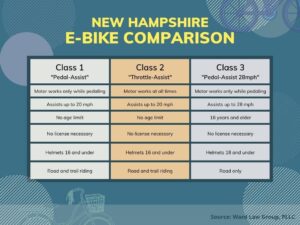Legislation to Make Roads and Trails Safer
While three classes of e-bikes are recognized in state statutes (see table), high-powered e-bikes don’t fit into any of those classes and are more like electric motorcycles, whether they have pedals or not. Those “Out-of-Class Electric Vehicles,” (OCEVs) such as e-bikes with motors rated at more than 750 Watts (one horsepower), some of which are capable of assisted speeds of 50 MPH or more, can pose a danger to users of multi-use trails. BWANH is evaluating potential legislation to clear up the statutory status of OCEVs, such as making it clear that they are not allowed on multi-use trails where motor vehicles are banned. OCEVs can still be used on those multi-use trails where ATVs are allowed. Legislation could address all unregulated micro-mobility devices including electric scooters, skateboards, one-wheelers, ball cycles, etc. These devices are often viewed as toys, but they can reach speeds over 20 MPH and pose safety hazards to all road and trail users. For more information or to help with the effort, contact info@bwanh.org.
When it comes to improving safety for cyclists on the road, BWANH is studying a range of bike safety measures that have already been enacted in other states. Based on national statistics, the two most dangerous situations for cyclists are navigating intersections and being passed. To address intersections, eleven states have adopted “stop-as-yield” laws that enable cyclists to treat stop signs as yield signs, enabling cyclists to get through an intersection more quickly and avoid conflicts with cars. Four states have adopted “Idaho stop” laws that enable cyclists to treat red lights as stop signs, again avoiding conflict with cars, particularly so-called “right hook” collisions, after a light turns green. And while New Hampshire’s three-feet-plus law is designed to protect cyclists when being passed by cars, it can be difficult to judge how much room a vehicle actually provides when passing. States have taken various approaches to passing-room laws, some requiring the car to leave the entire lane to the bike. Some state bike safety laws have also taken on unnecessary horn honking, since it can be dangerous to cyclists and other vulnerable road users, especially when combined with inadequate passing room. BWANH is currently studying a range of policies that could be incorporated into a bike safety bill; we plan to involve a range of stakeholders before formulating a policy proposal. For more information or to join the committee, contact info@bwanh.org.

Resources:



